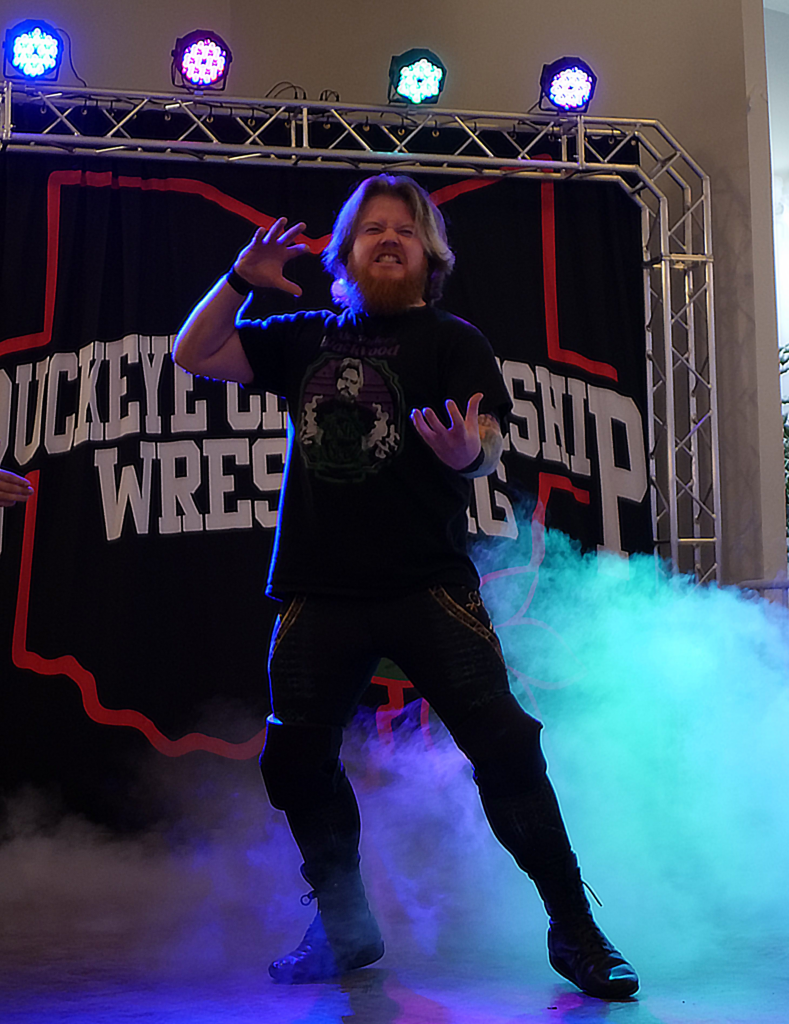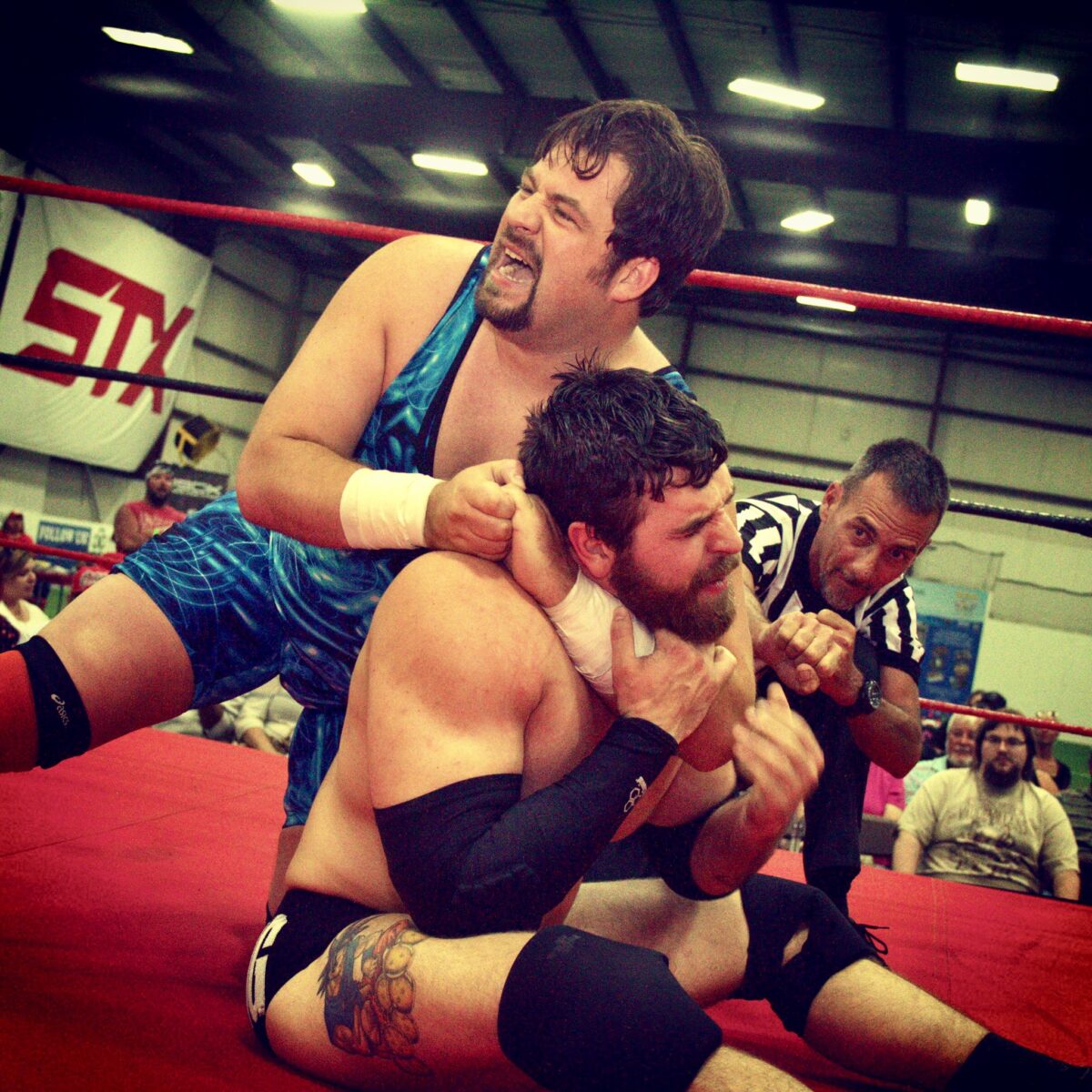An animated crowd was packed in the Skylight event space in Newark, anxiously awaiting the next wrestling bout at the James Avery Open Invitational Matchup when the funky tune of the Bee Gees’ “Stayin Alive” blared over the speakers.

Boos erupted from the crowd as Avery, a professional wrestler who lives in Newark, stepped through the curtain in the former Post Office building. He takes his time walking to the ring, and upon entry, he stands on the ropes as if to elevate himself over the audience and yells, “Hooray, for me!” only to be showered with jeers.
Avery shed his green robe as he stared down his opponent, “Mystic Seer” Alexander Blackwood. In the first few minutes of the match, Avery alternated between taunting the audience and toying with Blackwood — each move intentional and intended to elicit a reaction.
As he takes a lap around the ring, he stops by the announcer and takes the microphone. The referee calls for Avery to get back in the ring.
“You think I’m going to let a woman tell me what to do?” Avery taunted. He was met with more boos and the chant: “Avery sucks!”
Blackwood is popular with the crowd, but Avery has a considerable size advantage over him, and Avery knows it. Every time Blackwood tries to get up, Avery is right there to knock him back down to the mat.
After a few minutes of back-and-forth, Blackwood goes to the top rope in a last-ditch effort. Avery meets him before he can set his feet and suplexes Blackwood to the mat.
“It’s over!” Avery yells out to the crowd.
Avery circles Blackwood and attempts to pick him up. As if he had just awakened from a coma, Blackwood tries to roll Avery up in a surprise pin maneuver. Avery kicks out at two, rises to his feet quicker than Blackwood and lays him out with a stiff clothesline. He falls over Blackwood for the pin.
One.
Two.
Three.
Avery wins.
James Avery’s professional wrestling career began 24 years ago at 1333 W. Fifth Ave. — now a Dewey’s Pizza — in Columbus. He was 18, and it wasn’t much of a school then, but there was a ring and other people to train with.
After a couple of months, Avery felt a need for change, especially if he was serious about becoming a professional wrestler. He made the move to Florida, where he trained with the legendary Dory Funk Jr., the brother of professional wrestler Terry Funk. Funk Jr. began to make a name for himself in the 1960s, eventually winning the coveted National Wrestling Alliance World Heavyweight Championship.
Avery hoped Funk Jr.’s talent would rub off onto him. When he first arrived at the school, instead of thinking of ways to stand out, Avery remained reserved. By the time his last day there arrived, Avery decided to let loose.
“I’m like, ‘You know what? It’s the last day and I’m gonna start doing some backflips and just start showing off,’” Avery said. “Once I did, Dory Funk was like, ‘Oh, I didn’t know you could do all that. Heck, if I woulda known you could have done all that, I would have paid more attention to you.’”
Avery said he learned a valuable lesson: Don’t be afraid to fail.
He still applies that same philosophy 24 years later to his own training school, Ohio Pro Wrestling Academy, launched 12 years ago after prodding by his wife and an injury.
“What if I could take everything I’ve learned and put it into a young, healthy, athletic 18-year-old?” he asked his wife. “And she was like, ‘Why don’t you do that? Why don’t you just open a school? You’ve always talked about it.’”
Twelve years later, the academy is still going strong.
Avery stands in the ring, leaning over the top rope, as he welcomes a potential new crop of students. Though it was February, it felt like a beautiful spring day, with the sun shining through the big windows of the Skylight event space. His students spread out around the ring, one lacing their boots, another stretching, and another sweeping the mat in the ring. Avery looks over the four eager prospects. He gives it to them honestly.
“Today is for you all to decide if this is right for you. Wrestling is not for everyone. My style of wrestling is not for everyone,” Avery said.
One prospect shares that he is 35 years old. Avery grins. He knows someone at that age is considered “older” in professional wrestling.
It’s time to get in the ring and move around. He invites his students to go first so the prospective students can observe before trying it themselves. They started with basic rolling front flips across the ring, then backward.
Next, they learned to take their first “bump,” or landing on their back in the ring. Avery was in the ring the entire time, walking them through the steps of each movement. Each prospect took turns standing in the middle of the ring and throwing themselves on the mat back-first. Some of them are self-critical, but Avery remains encouraging.
“You’re going to mess up a ton early on,” Avery said. “The more you do it, the better you get at it.”
After an hour in the ring, it was time for informational interviews, when Avery emphasized transparency and joked that this was the part where the coaches would try to talk the prospective students out of joining.
During the interviews, Avery encouraged the prospects to consider how a 14-hour day — the average time spent during an independent wrestling promotion — might impact family members or jobs.
One of the prospects, Avery said, was married with a full-time job as a teacher: How would his relationship work if he was away every weekend at shows, or if his partner joined him on the road?
By the end of the interviews, Avery asked where people stood on a scale of one to 10. Three prospects were at a seven, and the last was at a 10. He and the other coaches chuckle a little that their pitch did not work. However, Avery insisted they sleep on it and talk with their families before deciding.
Avery emphasizes the importance of these conversations because he did not get those when he first started training. At 18 years old, Avery was not made aware of the harsh realities a career in professional wrestling entailed. He said you can give all you can to wrestling, but it will never love you back.


The success rate of a pro wrestler is low. In Avery’s school, nine out of 10 usually don’t finish because everything it takes to do this is too much. Birthdays, weekends away, and financial demands can be too much to manage. He wanted them to leave the building with everything they needed to know.
“I probably can’t teach all the right things to do, but I know how to do just about everything wrong, so let me do that for you,” Avery said.
If they decide to proceed, Avery has prepared to do everything in his power to turn them into professional wrestlers. His confidence is present, too. With over 10 students currently and several alums after 12 years of training, Avery knows he can produce talent.
Most professional wrestlers never make it to the highest levels, like World Wrestling Entertainment (WWE). Like many professional athletes chasing their dream of making it to the highest level of their craft, they spend years at the lower levels working toward any opportunity. In most cases, during those years on the independent wrestling scene, many support themselves through a daytime job to fund their passion on the weekends.
When he’s not running the school or away at events, Avery is a manager for a call center. He sits at home and tells people what to do, he said.
Avery can recount the times when wrestling was his only source of income. Making ends meet was often a challenge.
“[Most of it was] hoping you had enough gas to get from one place to the other, but wrestling is really one of those things. You’ve got to love it because, man, when you’re in it, it doesn’t love you back,” Avery said.
Independent wrestling is sort of like the Wild West — it’s a free-for-all, and it’s every man for himself. There is politicking, and the pay is usually low unless you’ve made a name for yourself, which is a challenge in itself. Instead of arenas of almost 10,000 fans, you find yourself in a high school gym with 200-300 fans in a small town an hour outside of the nearest city.
Avery is what many would consider a “career heel,” a devoted bad guy his entire time as a professional wrestler. It came easy to him. He feels people like to hate him, so he capitalizes on it. He made his own t-shirt that says “James Avery sucks!” on the front and his own custom championship belt he takes with him wherever he wrestles.
These are the places where James Avery made a career for himself. The career heel utilized these spaces to create an immersive experience for any fan who bought a ticket.
To have a career that spans the years James Avery has, it takes a level of resiliency that many do not have. From the beginning, Avery felt he always did the wrong thing or made choices that were not in his best interest. However, he stuck it out and kept working.
To pursue a career in professional wrestling is often viewed as an absurd choice. Whether it is because it’s that fake sport we see on television or the low pay, without question, the cons outweigh the pros. As Avery said, you have to love it to do it for a long time because it does not always love you back.
The wrestling ring has a steel frame, wooden boards, and a thin white mat. Much like any professional wrestler, any time Avery got a booking to wrestle and stepped into the ring, he risked it all. Wrestling can be a love story, but it can also be tragic. It’s fitting Avery walked out to the Bee Gees’ hit 1970s tune. In that song, survival is found in the streets of New York; for James Avery, it’s in the ring.
In 2023, Avery launched Buckeye Championship Wrestling, a Newark-based wrestling promotion organization that hosts wrestling events. Their debut event in January this year brought a “bakery deathmatch” to the Skylight, and they followed it up in April with another show.
The organization’s next event, called “DON’T POKE THE BEAR,” will take place at the Skylight, on the corner of E. Main and S. 1st streets in downtown Newark on Saturday, June 29.
Mike Maynard writes for TheReportingProject.org, the nonprofit news organization of Denison University’s Journalism program, which is supported by generous donations from readers. Sign up for The Reporting Project newsletter here.

